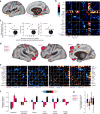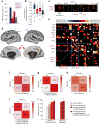Resting-state connectivity biomarkers define neurophysiological subtypes of depression
- PMID: 27918562
- PMCID: PMC5624035
- DOI: 10.1038/nm.4246
Resting-state connectivity biomarkers define neurophysiological subtypes of depression
Erratum in
-
Erratum: Resting-state connectivity biomarkers define neurophysiological subtypes of depression.Nat Med. 2017 Feb 7;23(2):264. doi: 10.1038/nm0217-264d. Nat Med. 2017. PMID: 28170383 Free PMC article.
Abstract
Biomarkers have transformed modern medicine but remain largely elusive in psychiatry, partly because there is a weak correspondence between diagnostic labels and their neurobiological substrates. Like other neuropsychiatric disorders, depression is not a unitary disease, but rather a heterogeneous syndrome that encompasses varied, co-occurring symptoms and divergent responses to treatment. By using functional magnetic resonance imaging (fMRI) in a large multisite sample (n = 1,188), we show here that patients with depression can be subdivided into four neurophysiological subtypes ('biotypes') defined by distinct patterns of dysfunctional connectivity in limbic and frontostriatal networks. Clustering patients on this basis enabled the development of diagnostic classifiers (biomarkers) with high (82-93%) sensitivity and specificity for depression subtypes in multisite validation (n = 711) and out-of-sample replication (n = 477) data sets. These biotypes cannot be differentiated solely on the basis of clinical features, but they are associated with differing clinical-symptom profiles. They also predict responsiveness to transcranial magnetic stimulation therapy (n = 154). Our results define novel subtypes of depression that transcend current diagnostic boundaries and may be useful for identifying the individuals who are most likely to benefit from targeted neurostimulation therapies.
Conflict of interest statement
The authors declare competing financial interests: details are available in the online version of the paper.
Figures





Comment in
-
Imaging biomarkers and biotypes for depression.Nat Med. 2017 Jan 6;23(1):16-17. doi: 10.1038/nm.4264. Nat Med. 2017. PMID: 28060802 No abstract available.
-
Biological Subtypes Bridge Diagnoses and Biomarkers: A Novel Research Track for Mental Disorders.Neurosci Bull. 2017 Jun;33(3):351-353. doi: 10.1007/s12264-017-0108-3. Epub 2017 Feb 21. Neurosci Bull. 2017. PMID: 28224286 Free PMC article. No abstract available.
-
US mental-health agency's push for basic research has slashed support for clinical trials.Nature. 2017 Jun 13;546(7658):339. doi: 10.1038/546338a. Nature. 2017. PMID: 28617481 No abstract available.
References
-
- Insel TR, Cuthbert BN. Medicine. Brain disorders? Precisely. Science. 2015;348:499–500. - PubMed
-
- Carroll BJ, et al. A specifc laboratory test for the diagnosis of melancholia. Standardization, validation, and clinical utility. Arch Gen Psychiatry. 1981;38:15–22. - PubMed
-
- Gold PW, Chrousos GP. Organization of the stress system and its dysregulation in melancholic and atypical depression: high vs low CRH/NE states. Mol Psychiatry. 2002;7:254–275. - PubMed
-
- Lewy AJ, Sack RL, Miller LS, Hoban TM. Antidepressant and circadian phase-shifting effects of light. Science. 1987;235:352–354. - PubMed
Publication types
MeSH terms
Grants and funding
LinkOut - more resources
Full Text Sources
Other Literature Sources
Medical

